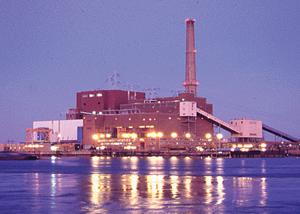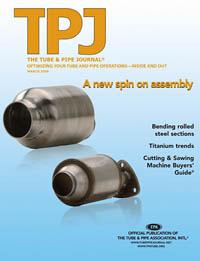- FMA
- The Fabricator
- FABTECH
- Canadian Metalworking
Categories
- Additive Manufacturing
- Aluminum Welding
- Arc Welding
- Assembly and Joining
- Automation and Robotics
- Bending and Forming
- Consumables
- Cutting and Weld Prep
- Electric Vehicles
- En Español
- Finishing
- Hydroforming
- Laser Cutting
- Laser Welding
- Machining
- Manufacturing Software
- Materials Handling
- Metals/Materials
- Oxyfuel Cutting
- Plasma Cutting
- Power Tools
- Punching and Other Holemaking
- Roll Forming
- Safety
- Sawing
- Shearing
- Shop Management
- Testing and Measuring
- Tube and Pipe Fabrication
- Tube and Pipe Production
- Waterjet Cutting
Industry Directory
Webcasts
Podcasts
FAB 40
Advertise
Subscribe
Account Login
Search
Titanium trends
Energy demand, titanium demand grow hand-in-hand
- March 9, 2009
- Article
- Tube and Pipe Fabrication
Although titanium was discovered in the late 18th century, it wasn't until 1940 that a metallurgist, Dr. William Kroll, first devised a commercially viable process for extracting the metal from its raw ore. In the 1950s titanium was recognized for its high strength and light weight, making it the new wonder metal in the aerospace industry. Furthermore,its corrosion resistance led to its widespread use in power plant condensers and chemical applications.
The first use of titanium tubing in a power plant surface condenser in the U.S. was at the Teche power station (Baldwin, La.) in 1970. The Arthur Kill generating station (Staten Island, N.Y.) followed immediately in 1971. In the ensuing decades, hundreds of power plants worldwide installed titanium condenser tubing without a single reported corrosion event. In fact, nearly 40 years after it was built, the Arthur Kill station is still operating with the same titanium condenser tubes that were supplied in 1971.
Energy demand and supply are anything but static. The Energy Information Administration (EIA), which releases official energy statistics for the Department of Energy (DOE), recently issued a report that predicts energy needs in the U.S. will increase from about 4,000 billion kilowatt-hours in 2008 to around 5,000 billion kilowatt-hours in 2030 (see Figure 1). Meeting this demand will require the equivalent of more than 20 new, 500-megawatt (MW) power plants per year.
The energy supplied will come from a variety of sources. One of these is nuclear power. The Nuclear Regulatory Commission (NRC) has received 17 applications for combined operating licenses (COLs). These 17 COLs will add 26 new nuclear units in the U.S. over the next several years, with an average generating capacity of 1,000 MW. Although shunned by some, nuclear power provides the most power per unit and produces a minimal carbon footprint. Some environmentalists have embraced it during the past few years.
This trend, the so-called "nuclear renaissance," bodes well for titanium tubing producers and fabricators.
Why Titanium Tubing?
While immunity to seawater corrosion is its most important benefit, titanium is also the best choice for condenser tubing in electricity-generating stations, whether they are nuclear-, coal-, or gas-powered. First, titanium's naturally occurring oxide film makes it impervious to chloride ion attack. In addition, when conditions permit, titanium can be specified without a corrosion allowance. Second, its combination of high strength and corrosion resistance means that, compared to competing materials, titanium condenser tubing can have thinner walls, increasing heat transfer efficiency. Third, the lack of corrosion makes cleaning and maintenance easier. Last, titanium extends the life cycle of the condenser. While other materials might require replacement after 20 years, titanium tubing has operated successfully worldwide in plants for 40 years, providing significant cost savings over the life of the power plant.
Rating Suppliers
When choosing a tubing supplier, the condenser fabricator, engineering company, and end user must consider factors such as:
- A reference list for condensers. A large favorable reference list is required, particularly for nuclear units. Has the tubing manufacturer provided tubing to a nuclear unit before? Have any problems arisen at the installation? If it hasn't supplied tubing for a nuclear installation, has it supplied titanium tubing for other condenser applications?
- Raw material supply. The world's titanium supply has been limited during the past few years. Does the tubing manufacturer have access to enough titanium to deliver as promised? Access to more than one supplier is crucial. This applies not only to titanium, but also to other specialty materials that it might offer as substitutes.
- Manufacturing capability. Can the producer allocate enough mill time to produce the tubing in the delivery window required? Most manufacturers do not have a lot of storage capacity, so they don't want to allocate resources too far in advance. For this reason, large projects usually require a small number of substantial deliveries in a tight time frame.
Manufacturing Titanium Tubing
Titanium is cold-formed without lubricants and welded without filler metal. Following the welding, titanium tubing typically is sized and stress-relieved. During or after these processes, the tubing undergoes stringent testing per the specification.
For nuclear applications, and possibly for all titanium condenser tubing applications, future requirements are likely to exceed current ones (ASTM B338 and ASME SB338). For example, the nondestructive examination (NDE) requirements are expected to be far more stringent than current requirements. Ultrasonic testing (UT) with both longitudinal and transverse notches, plus chart recording of UT testing of each tube, inclusive of weld thickness; eddy current testing with additional decibels, thus rejecting tubing that would normally be considered acceptable; and an emphasis on increasing the frequency of mechanical testing will become the norm for nuclear applications. Certification and traceability of each heat and tube may be required.
Expertise in forming and welding titanium is critical for successfully turning titanium strip into titanium tube. Although the practices for forming and welding of titanium are somewhat similar to those of stainless alloys, titanium's high raw material cost and limited availability make scrap relatively more expensive than it is for other materials. Poor tubing yields generate financial losses and delay delivery schedules, which are critical in both new-unit construction and in retrofits.
Rick Chapman is plant manager and Wendy McGowan is manager of sales and marketing for Valtimet, 5501 Air Park Blvd., Morristown, TN 37813, 423-587-1888, www.valtimet.com.
About the Publication
Related Companies
subscribe now

The Tube and Pipe Journal became the first magazine dedicated to serving the metal tube and pipe industry in 1990. Today, it remains the only North American publication devoted to this industry, and it has become the most trusted source of information for tube and pipe professionals.
start your free subscription- Stay connected from anywhere

Easily access valuable industry resources now with full access to the digital edition of The Fabricator.

Easily access valuable industry resources now with full access to the digital edition of The Welder.

Easily access valuable industry resources now with full access to the digital edition of The Tube and Pipe Journal.
- Podcasting
- Podcast:
- The Fabricator Podcast
- Published:
- 04/16/2024
- Running Time:
- 63:29
In this episode of The Fabricator Podcast, Caleb Chamberlain, co-founder and CEO of OSH Cut, discusses his company’s...
- Trending Articles
Team Industries names director of advanced technology and manufacturing

Orbital tube welding webinar to be held April 23

Chain hoist offers 60-ft. remote control range

Push-feeding saw station cuts nonferrous metals

Corrosion-inhibiting coating can be peeled off after use

- Industry Events
16th Annual Safety Conference
- April 30 - May 1, 2024
- Elgin,
Pipe and Tube Conference
- May 21 - 22, 2024
- Omaha, NE
World-Class Roll Forming Workshop
- June 5 - 6, 2024
- Louisville, KY
Advanced Laser Application Workshop
- June 25 - 27, 2024
- Novi, MI



























